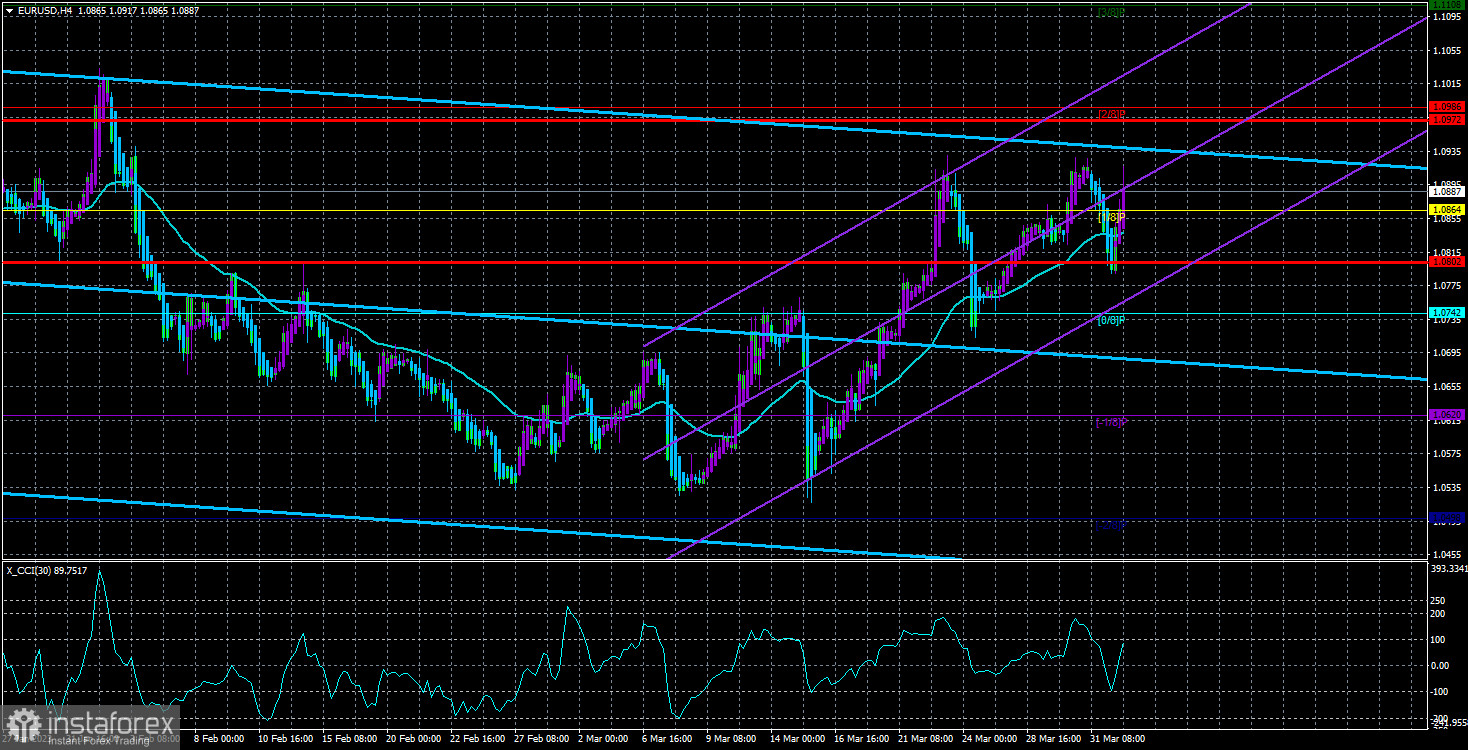
The EUR/USD currency pair could remain unchanged throughout Monday's trading session. It traded quite volatilely despite not doing this. Maybe the volatility indicator did not go off the chart, but 128 points on a nearly empty Monday is a lot. A significant movement started during the night, and the European currency continued to decline on Friday. However, the fall abruptly ceased, and the pair surged upwards. Again, we emphasize the lack of logic in the movements, not only from a fundamental or macroeconomic standpoint but also from a technical standpoint. Only on Friday did the pair surpass the moving average line, giving reason to anticipate a drop of at least 100 points between Monday and Tuesday. On Monday, though, we witnessed a significant growth rate. However, the pair had been growing for several weeks without apparent cause. Although it is close to the significant 50.0% Fibonacci level in the 24-hour time frame, the price is falling. And this is even though it has already increased by 1,500 points and has been unable to normalize itself following this movement.
If this week's rise continues, it will be absurd. It will be an inertial movement without connection to the foundation or macroeconomics. Remember that last week there were virtually no significant events. It is feasible to separate the report on European Union inflation, which has declined considerably, while core inflation has increased at the same time. This report cannot be construed unambiguously in favor of the dollar or the euro. Uncertainty, lack of logic, and confusion of the highest degree. Given the conditions, switching to the highest or lowest charts is preferable. In the first scenario, you will have to trade for an extended period, but the price changes are more or less attractive. In the second scenario, intraday trends can be identified.
The ISM index is deteriorating, but traders are unconcerned.
Two reports on business activity in the EU and the United States manufacturing sector are the only things that can be distinguished on Monday. In addition, the first could be securely disregarded because it was the second and last evaluation of the indicator. The ISM index in the United States is already more intriguing. In March, the ISM dropped from 47.7 points in February to 46.3 points. Traders anticipated values between 47.5-20.0. So, the predictions didn't come true, and after this report, the dollar kept falling during the day. Hence, at the end of the trading day, the pair was once again trading near its local highs, casting doubt on its potential to decline in the near future. Therefore, everything merely signals that the movement to the south should commence. Yet if the market is buying today because it expects the pair to grow further, neither the underlying economics nor the macroeconomics matter.
Even Friday's nonfarm report in the United States will not include it. This report is quite significant, but it will only create a local reaction, after which market participants will return to their primary trend. Additionally, what relevance do nonfarm payrolls have today? The Fed is unlikely to announce a further tightening of monetary policy if it comes out strong (together with the unemployment rate). It simply does not require it under the present conditions. If it turns out to be weak (along with the unemployment rate), the dollar will decline again, as has been the case for the past six months. This report will have a minimal impact on anything. And there are a few significant events scheduled during the week. Certainly, there will be several speeches by representatives of the ECB and the Fed, but the next meetings are still quite distant, and the rhetoric of these departments' members stays the same. On the 4-hour TF, the pair is once again above the moving average and may drop below the moving average today. The growth on Monday appeared again to be irrational.

As of April 4, the average volatility of the euro/dollar currency pair over the previous five trading days was 85 points, which is considered "normal." We, therefore, anticipate the pair to trade between 1.0802 and 1.0972 on Tuesday. A Heiken Ashi indicator reversal to the downside will signal a new bout of bearish movement.
Nearest support levels:
S1 – 1.0864
S2 – 1.0742
S3 – 1.0620
Nearest resistance levels:
R1 – 1,0986
R2 – 1.1108
R3 – 1.1230
Trading Recommendations:
The EUR/USD currency pair has returned to consolidate above the moving average line. You can maintain long positions with targets between 1.0972 and 1.0986 until the Heiken Ashi indicator declines. Once the price falls below the moving average line, new short options can be opened with goals of 1.0802 and 1.0742.
Explanations for the illustrations:
Channels of linear regression – aid in determining the present trend. If both move in the same direction, the trend is strong.
Moving average line (settings 20.0, smoothed) – determines the current short-term trend and trading direction.
Murray levels serve as movement and correction targets.
Volatility levels (red lines) represent the expected price channel the pair will trade within over the next trading day based on the current volatility indicators.
The CCI indicator — its entry into the oversold area (below -250) or the overbought area (above +250) indicates that a trend reversal is imminent.
 English
English 
 Русский
Русский Bahasa Indonesia
Bahasa Indonesia Bahasa Malay
Bahasa Malay ไทย
ไทย Español
Español Deutsch
Deutsch Български
Български Français
Français Tiếng Việt
Tiếng Việt 中文
中文 বাংলা
বাংলা हिन्दी
हिन्दी Čeština
Čeština Українська
Українська Română
Română

